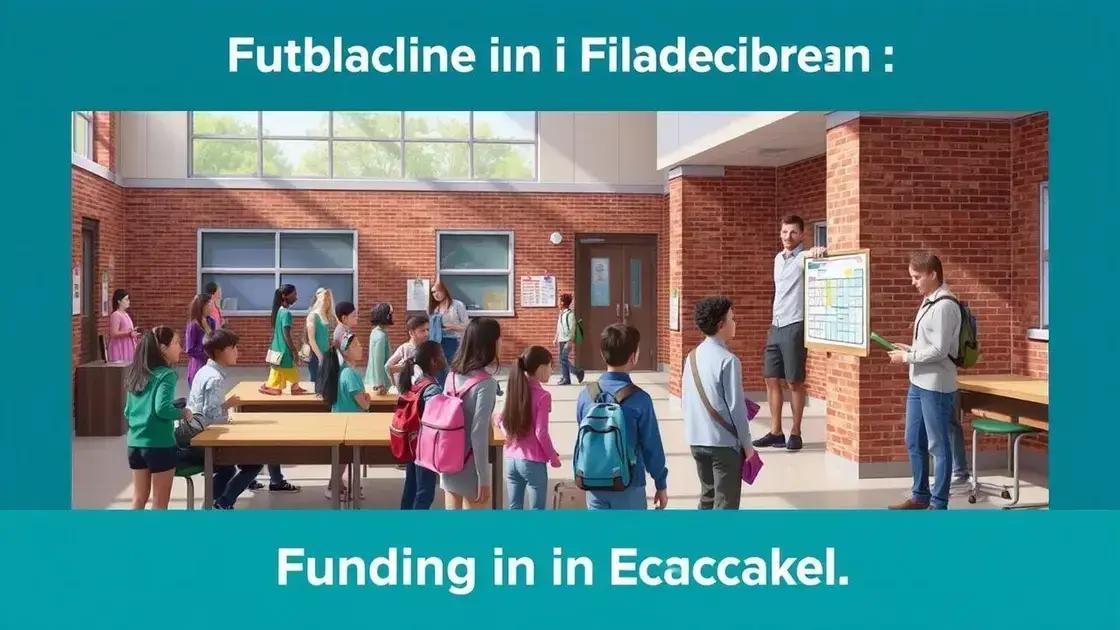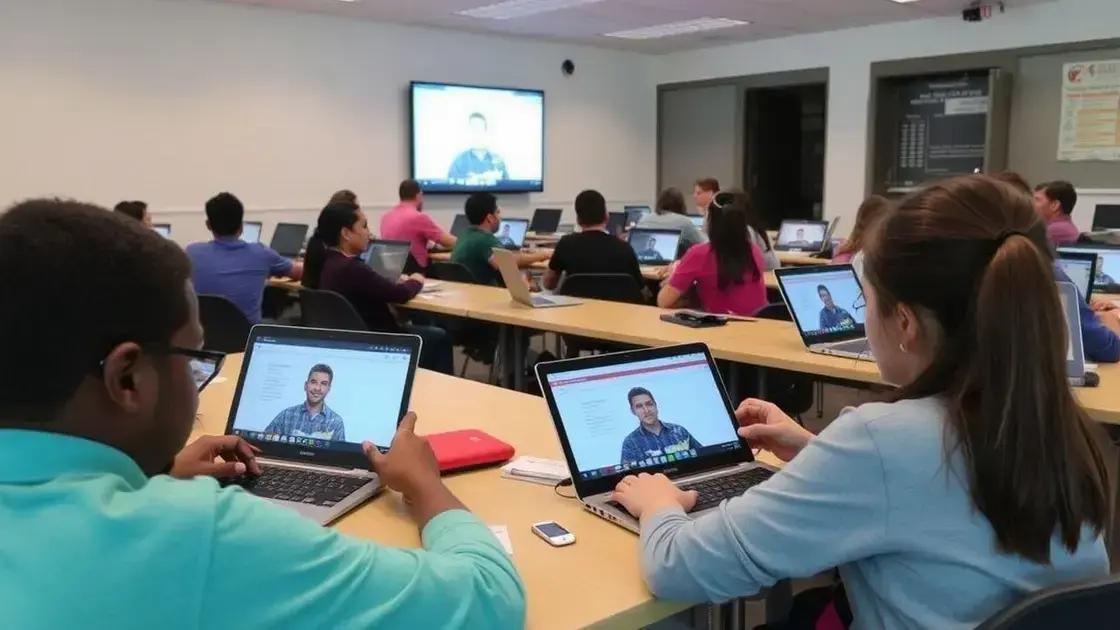Public school funding: understanding the challenges

Community involvement is vital for enhancing public school funding, as it fosters support through volunteering, fundraising events, and advocacy, ultimately leading to better educational resources and improved student outcomes.
Public school funding plays a vital role in shaping the quality of education our children receive. Have you ever wondered how school budgets influence your community? Let’s dive into this essential topic.
The significance of public school funding
The significance of public school funding cannot be overstated. Funding shapes the quality of education students receive and directly impacts their future opportunities. When resources are limited, schools struggle to provide necessary materials and programs.
In this context, adequate funding ensures that students have access to qualified teachers, updated technology, and engaging learning environments. Let’s explore some key aspects of this importance.
Why Funding Matters
Funding is essential for maintaining educational standards. When schools receive proper financial support, they can:
- Offer a variety of programs like arts and sciences
- Ensure class sizes remain manageable
- Provide essential support services such as counseling
Moreover, funding helps to close the achievement gap. Disadvantaged schools can often rely on government programs to level the playing field.
It’s important to understand how inequitable funding leads to disparities among schools. Areas with higher property taxes often see better-funded schools, while low-income neighborhoods struggle with limited resources.
Impact on Student Outcomes
Research shows that schools with sufficient funding tend to have better student outcomes. These schools:
- Witness higher graduation rates
- Have lower dropout rates
- Provide a more enriching educational experience
Investing in public school funding is investing in the future. When we focus on enhancing school budgets, we pave the way for our children to succeed. By prioritizing funding, communities can foster nurturing educational environments that cultivate talent and innovation.
How funding impacts educational quality
How funding impacts educational quality is an essential topic that deserves attention. The amount of money allocated to schools significantly determines the resources available, which directly affects the learning experience for students.
When schools receive adequate funding, they can invest in critical areas such as teacher salaries. Well-paid teachers are often more motivated and can contribute to better student outcomes. This financial support also allows schools to offer professional development, which keeps teachers updated with the latest educational practices.
Resources Available
With appropriate funding, schools can provide a wide range of resources, including:
- Updated technology like computers and software
- Access to library materials and textbooks
- Extracurricular activities such as sports and arts
Such resources create a more engaging environment where students can thrive. When students participate in various programs, they develop skills beyond the classroom, fostering creativity and teamwork.
The impact of funding also extends to class sizes. Smaller class sizes are linked to better learning conditions. Teachers can give more individualized attention, allowing for a deeper understanding of the material.
The Role of Community Support
Community involvement is also crucial in enhancing educational quality. When communities invest in their schools, whether through fundraising or volunteering, the overall educational experience improves. Additionally, strong community ties help address any funding gaps.
It’s important to note that research shows a direct correlation between funding and academic performance. Schools with sufficient financial backing tend to perform better on standardized tests and achieve higher graduation rates. Overall, when we ensure proper funding, we create an environment where both teachers and students can excel.
Common challenges in public school funding

Common challenges in public school funding are significant issues that affect education systems across the country. Many schools struggle to secure the necessary funds to provide the quality education that every student deserves. Understanding these challenges helps highlight the need for reform.
A major challenge is the inequitable distribution of funding. Schools in affluent areas often receive more financial support due to higher property taxes, while schools in low-income neighborhoods face severe limitations. This discrepancy leads to unequal educational opportunities.
Budget Constraints
Another challenge schools face is budget constraints. Funding is often tied to state and local budgets, which can fluctuate based on economic conditions. When budgets are tight, schools may have to cut essential programs, including arts and sports, impacting student engagement.
- Limited technology resources
- Inadequate teacher salaries
- Reduced extracurricular activities
These budget constraints create a ripple effect, affecting everything from classroom resources to opportunities for student enrichment.
Additionally, political factors play a critical role in public school funding. Decisions made by lawmakers can impact how funds are allocated. In some cases, political disagreements over budgeting can stall necessary funding reforms, leaving schools in uncertain situations.
Relying on Grants and Donations
Many schools find themselves increasingly reliant on grants and private donations to fill funding gaps. While these resources can be helpful, they are often unpredictable and can lead to disparities between schools that can secure funding and those that cannot. Schools that cannot attract such resources may struggle to meet their students’ needs.
In this complex landscape of funding challenges, the need for advocacy and community action has never been more critical. Schools need support from parents, community members, and local businesses to create an educational environment where all students can thrive. Addressing these challenges will require a concerted effort from all stakeholders involved.
Innovative funding solutions for schools
Innovative funding solutions for schools are essential for addressing the financial gaps many educational institutions face today. With traditional funding avenues becoming insufficient, schools need to explore new strategies to secure necessary resources.
One effective solution is the use of public-private partnerships. These partnerships can help schools gain access to funding from local businesses and organizations. By collaborating with the community, schools can create programs that benefit both the students and the local economy.
Crowdfunding Initiatives
Another innovative approach is crowdfunding. Schools can utilize online platforms to raise money for specific projects or needs. Parents, alumni, and community members can contribute, helping schools meet their financial goals. This method not only raises funds but also fosters community engagement.
- Support for arts and sports programs
- Funding for classroom technology upgrades
- Resources for extracurricular activities
Engaging the local community is vital in these efforts. Schools should promote their campaigns through social media, newsletters, and community events to generate interest and encourage donations.
Grant Applications
Applying for grants is another avenue schools can explore. Many organizations offer grants specifically aimed at enhancing educational quality. Schools should focus on identifying applicable grants, preparing strong applications, and demonstrating their needs effectively.
Additionally, some districts are implementing funding cooperatives where multiple schools share resources and funding sources. This collaborative approach allows schools to pool their resources and tackle financial challenges more efficiently.
More schools are also adopting micro-donations from the community. This strategy allows small, regular contributions that add up over time. It’s an approach that makes giving easy and accessible for donors.
Innovative funding solutions not only provide immediate help but also build a culture of support and investment in education. By thinking outside the box, schools can better serve their students and communities.
The role of community in school funding
The role of community in school funding is crucial for supporting educational initiatives. When communities engage with schools, they create a powerful network that enhances student success. Community involvement can take many forms, including volunteering, fundraising, and advocating for better resources.
Active participation helps schools identify their specific needs and tailor responses accordingly. By coming together, community members can effectively support school programs. This collaboration often leads to stronger relationships between schools and the community.
Volunteering and Support
Volunteers play a critical role in enriching the educational experience. Parent-teacher associations (PTAs) often organize events to raise funds for essential resources. These events can include:
- Book fairs to promote literacy
- Community dinners to foster school spirit
- Sport events to bring families together
Not only do these activities raise money, but they also strengthen ties between families and schools. Such connections create a network of support that directly benefits students.
Advocacy and Awareness
Communities also have the power to advocate for school funding at a broader level. This advocacy can include contacting local representatives to discuss budget allocations. By voicing their needs, community members can influence policies that impact educational financing.
Raising awareness about funding issues is equally important. When communities understand how funding affects education quality, they are more likely to take action. Hosting informational sessions can help raise consciousness and draw attention to vital funding challenges.
Ultimately, the engagement of communities in school funding creates a culture of support and accountability. When parents, local businesses, and community leaders work together, they can create a more stable financial foundation for schools. This collaboration not only impacts current students but also sets the stage for future generations.
FAQ – Frequently Asked Questions about Community Involvement in School Funding
How can my community support local schools?
Your community can support local schools by volunteering for events, participating in fundraisers, and advocating for educational funding.
What types of fundraising events can our community organize?
Communities can organize various events like bake sales, car washes, and fun runs to raise money for school programs and resources.
Why is advocacy important for school funding?
Advocacy is crucial because it helps raise awareness about funding issues and influences policymakers to allocate more resources to schools.
How does community involvement impact student outcomes?
Community involvement leads to better resources, improved programs, and stronger support networks, all of which contribute to enhanced student success.






